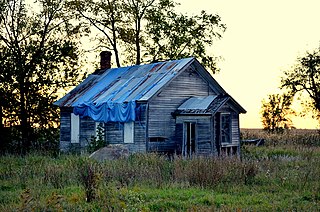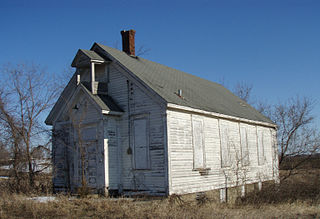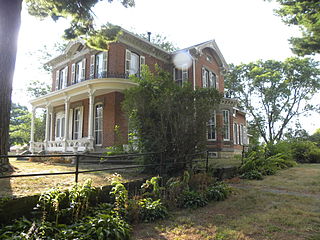
One-room schools, or schoolhouses, were commonplace throughout rural portions of various countries, including Prussia, Norway, Sweden, the United States, Canada, Australia, New Zealand, the United Kingdom, Ireland, Portugal, and Spain. In most rural and small town schools, all of the students met in a single room. There, a single teacher taught academic basics to several grade levels of elementary-age children. While in many areas one-room schools are no longer used, some remain in developing nations and rural or remote areas where scarce students or teachers complicate organizing the educational process differently.

Wawaset Park is a planned community national historic district located on the western edge of the City of Wilmington, New Castle County, Delaware. The area was formerly the grounds of Schuetzen Park, a horse racing and later auto racing track and fairgrounds. It was purchased in 1917 by the DuPont Company and developed into single-family houses, semi-detached and row houses to meet the housing need for the company's expanding corporate staff. The historic district encompasses 321 contributing buildings and 1 contributing structure.

The Pioneer School stands in an isolated location in Park County, Wyoming, about 8 miles (13 km) north of Clark, in the Clark Fork Valley near the Montana border. The frame structure is an example of a country school built to serve students in rural areas prior to the introduction of school bus routes to more centrally located facilities. Built in 1914, it was a one-room schoolhouse until 1953, and it operated until 1967.

The Iowa State Fairgrounds is located on the east side of Des Moines, Iowa, United States. It annually hosts the Iowa State Fair in late summer. The state fair was begun in Iowa in 1854 and the current fairgrounds were established in 1886. The fairgrounds were listed as a historic district on the National Register of Historic Places in 1987 as the Iowa State Fair and Exposition Grounds.

The Redford Township District No. 5 School is a school building located at 18499 Beech Daly Road in Redford, Michigan. After 1923, the school was known as the Redford Union District No. 1 School, and the building was also called the Beech Road School. It is now known as the John C. Raeside Administration Building. It was designated a Michigan State Historic Site in 1994 and listed on the National Register of Historic Places in 1997.
The Round Barn, Norway Township is a historical building located in rural Norway Township, Winnebago County, Iowa, United States. It was built in 1920 as a dairy and horse barn. The building is a true round barn that measures 53 feet (16 m) in diameter. It is constructed of clay tile from the Johnston Brothers' Clay Works in Webster County. It features an aerator, conical roof and a hay dormer on the south side. The barn has been listed on the National Register of Historic Places since 1987.
The Round Barn, Washington Township is a historic building located near Sciola in rural Montgomery County, Iowa, United States. It was built in 1917 as a hog barn. Typical of a barn built for this use in features a multitude of windows on the wall and on the cupola, which provided light and ventilation. The building is a 24-sided structure that measures 60 feet (18 m) in diameter. The barn features red vertical siding, a 12-section cupola, and a two-pitch sectional roof. It has been listed on the National Register of Historic Places since 1986.

The Octagon Barn, Otter Township is a historic building located near Milo in rural Warren County, Iowa, United States. It was built in 1900 as a horse and dairy barn. The octagon-shaped building measures 54 feet (16 m) in diameter. The structure features a tall center section with a winged shed around it. It is covered in red horizontal siding and is topped by a sectional conical roof. It has been listed on the National Register of Historic Places since 1986.

The Metamora Crossroads Historic District is a historic district centered at the intersection of Oak and High Street in the small village of Metamora in Metamora Township in Lapeer County, Michigan. It was designated as a Michigan State Historic Site and also added to the National Register of Historic Places on July 19, 1984.

Wilson District No. 7 School, also known as the O'Meara Schoolhouse, is an historic structure located in rural Clinton County, Iowa, United States near the town of Delmar. The one-room school was listed on the National Register of Historic Places in 2004. The listing includes three structures: the former school building and two outhouses.

The Helvig–Olson Farm Historic District is an agricultural historic district located in rural Clinton County, Iowa, United States, 3 miles (4.8 km) southwest of the town of Grand Mound. It was listed on the National Register of Historic Places in 2000.

District No. 48 School, later Franklin Township Hall, is a historic one-room school in Franklin Township, Minnesota, United States, built in 1871. It was listed on the National Register of Historic Places in 1979 for having local significance in the themes of architecture and education. It was nominated as an example of the early schoolhouses built throughout rural Wright County in the late 19th century. It is now vacant.
John McGreer Barn and Crib are a historic building (barn) and structure located in rural Harrison Township, Lee County, Iowa, United States. They are located on a farm northwest of the town of Donnellson. The agricultural buildings were listed on the National Register of Historic Places in 2001.

The Earlham Public School is a historic building located in Earlham, Iowa, United States. The town's name was chosen by the Quakers, who were the largest group of settlers in the community. They named it for Earlham College in Richmond, Indiana because they intended to establish a similar institution in the town. Fundraising got underway in 1869, and the following year plans were made to establish a public befitting a college town. Earlham Public School open in 1871. Jennings P. Osborn, a local builder, constructed the two-story structure of smooth-faced limestone that rests on rusticated limestone foundation. The building soon proved to be too small and a brick addition was added to the south side of the original building.

Steamboat Rock Consolidated Schools Building, also known as the Steamboat Rock Community School, is a historic building located in Steamboat Rock, Iowa, United States. The first school in town was a one-room school that opened a year after the town was platted in 1855. A two-story brick school building was completed in 1869. Beginning in 1919 rural school districts began to merge with the Steamboat Rock district, which began to substantially increase the student population. The main part of this school building was completed in 1928. The gymnasium/music room/shop building was added in 1956 to accommodate the post World War II baby boom. As the 20th century continued the population in rural areas declined, which affected enrollment. The Steamboat Rock School merged with the Wellsburg and Ackley-Geneva districts in 1997, and this building was left empty. The city acquired it in 1999, and it now houses a variety of retail businesses and offices. The building was listed on the National Register of Historic Places in 2004.

Briggs Terrace, also known as Evergreen Lane, is a nationally recognized historic district located in Nevada, Iowa, United States.

The John Hultquist House is a historic building located in Swedesburg, Iowa, United States. Hultquist was a native of Småland in Sweden who immigrated to this country in 1880. After working for the Chicago, Burlington and Quincy Railroad he began farming and he was eventually able to buy 200 acres (81 ha) of land for his own farm north of town. In 1918 Hultquist employed C.K. Schantz to build this two story, frame, American Foursquare for him and his second wife Amanda after his retirement. It was fairly common for the early Swedish immigrants in Wayne Township to relocate to Swedesburg after they retired from farming so as to maintain their Swedish traditions. The house was listed on the National Register of Historic Places in 1999. The historic designation also includes a small barn to the east of the house. The front gable structure originally housed horses, a cow and chickens.

The Oxford Commercial Historic District is a nationally recognized historic district located in Oxford, Iowa, United States. It was listed on the National Register of Historic Places in 1997. At the time of its nomination it consisted of 20 resources, which included 16 contributing buildings and four non-contributing buildings. This district reflects a typical central business district found in a Midwest town. It represents a transitional period from a frontier town to a settled community, and from the horse as the primary means of transportation to the automobile and mechanized farming. Most of the buildings in Oxford's business district were constructed between 1883 and 1917. Some replaced the wood-frame structures from the town's frontier days, while others replaced those destroyed by a major fire that consumed the north side of the district in 1890. They are one to two stories in height, and their exteriors are composed of common brick. While simple in composition, many feature ornate decorative cornices. The Italianate and Romanesque Revival styles dominate.

Eagar Townsite Historic District is a section of the town of Eagar, Arizona which has been designated a National Historic Place. Sitting on roughly 54 acres, the site contains 37 structures, 21 of which have historical significance. The period of significance is from 1886, the year the townsite was founded, through 1942, which represents the significant period of development of the town. The site was added to the Register on July 23, 1993.

The First National Bank of Davenport, also known as Brenton Bank and The Brenton, is a historic building located in central Davenport, Iowa, United States. It was added to the National Register of Historic Places in 2018. It is significant for its associations with the history of community planning and development, and as an important example of modernistic design.




















